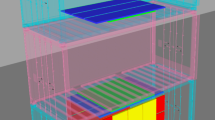Abstract
Introduction
Muon scattering tomography (MST) can be employed to scan cargo containers and vehicles for special nuclear materials by using cosmic muons. However, the flux of cosmic ray muons is relatively low for direct detection. Thus, the detection has to be done in a short timescale with small numbers of muons to satisfy the demands of practical applications.
Method
In this paper, we propose an artificial neural network (ANN) algorithm for material discrimination using MST. The muon scattering angles were simulated using Geant4 to formulate the training set, and the muon scatter angles were measured by Micromegas detection system to create the test set.
Results
The ANN-based algorithm presented here ensures a discrimination accuracy of 98.0% between aluminum, copper and tungsten in a 5 min measurement of 4 × 4 × 4 cm3 blocks.











Similar content being viewed by others
References
K.A. Olive, K. Agashe, C. Amsler et al., Review of particle physics. Chin. Phys. C 38, 090001 (2014)
K.N. Borozdin et al., Surveillance: radiographic imaging with cosmic-ray muons. Nature 422, 277 (2003)
V. Anghel et al., A plastic scintillator-based muon tomography system with an integrated muon spectrometer. Nucl. Instrum. Methods A 798, 12 (2015)
W. Priedhorsky et al., Detection of high-Z objects using multiple scattering of cosmic ray muons. Rev. Sci. Instrum. 74, 4294 (2003)
K. Gnanvo, L. Grasso, M. Hohlmann, J. Locke, A. Quintero, D. Mitra, Imaging of high-Z material for nuclear contraband detection with a minimal prototype of a muon tomography station based on GEM detectors. Nucl. Instrum. Methods A 652, 16 (2011)
P. Baesso et al., A high resolution resistive plate chamber tracking system developed for cosmic ray muon tomography. JINST 8, P08006 (2013)
X. Wang et al., The cosmic ray muon tomography facility based on large scale MRPC detectors. Nucl. Instrum. Methods A 784, 390 (2015)
Y. Giomataris et al., MICROMEGAS: a high-granularity position-sensitive gaseous detector for high particle-flux environments. Nucl. Instrum. Methods A 376, 29 (2015)
H. Gomez et al., Muon tomography using micromegas detectors: from archaeology to nuclear safety applications. Nucl. Instrum. Methods A 936, 14 (2019)
W. He, S. Xiao, M. Shuai et al., A grey incidence algorithm to detect high-Z material using cosmic ray muons. JINST 12, P10019 (2017)
W. He, S. Xiao, Y. Li et al., Discrimination of high-Z materials in sealed containers with cosmic ray muons. JINST 13, P10017 (2018)
G. Bonomi, P. Checchia, M. Derrico et al., Application of cosmic-ray muons. Prog. Part. Nucl. Phys. 112, 103768 (2020)
S. Xiao, W. He, M. Lan, Y. Chen, M. Shuai, A modified multi-group model of angular and momentum distribution of cosmic ray muons for thickness measurement and material discrimination of slabs. Nucl. Sci. Tech. 29, 1 (2018)
Particle Data Group Collaboration, J. Beringer et al., Review of particle physics (RPP). Phys. Rev. D 86, 010001 (2012)
GEANT4 Collaboration, S. Agostinelli et al., GEANT4: a simulation toolkit. Nucl. Instrum. Methods A 506, 250 (2003)
C. Hagmann, D. Lange, D. Wright, Cosmic-ray shower generator (CRY) for monte carlo transport codes, in 2007 IEEE Nuclear Science Symposium and Medical Imaging Conference (NSS/MIC) (2007)
Z. Zhang et al., Manufacture and performance of the thermal-bonding Micromegas prototype. JINST 9, C10028 (2014)
J. Feng, Z. Zhang, J. Liu et al., A thermal bonding method for manufacturing Micromegas detectors. Nucl. Instrum. Methods A 989, 164958 (2021)
S. Liu, S. Ma, B. Qi et al., An extensible induced position encoding readout method for micropattern gas detectors. IEEE Trans. Nucl. Sci. 65(2), 777–780 (2018)
Y. Wang, Z. Zhang, S. Liu et al., A high spatial resolution muon tomography prototype system baesd on micromegas detector. IEEE Trans. Nucl. Sci. 69(1), 78–85 (2022)
T. Cong, G. Su, S. Qiu et al., Applications of ANNs in flow and heat transfer problems in nuclear engineering. Prog. Nucl. Energy 62, 54–71 (2013)
MATLAB (The Mathworks, Inc). http://www.mathworks.com
G.E. Cantarella, S. de Luca, Multilayer feedforward networks for transportation mode choice analysis: an analysis and a comparison with random utility models. Transp. Res. Part C 13, 121–155 (2005)
J. Kim, K. Park, G. Cho, Multi-radioisotope identification algorithm using an artificial neural network for plastic gamma spectra. Appl. Radiat. Isot. 147, 83–90 (2019)
Acknowledgements
This work was supported by the Program of National Natural Science Foundation of China Grant Nos. 11805168 and 21805251. Thanks are due to Dr. Zhiyong Zhang for designing the micromegas detectors and Prof. Changqing Feng for providing the readout electronics. The authors would like to thank Prof. Shubin Liu and Dr. Yu Wang for their assistance with the muon tomography experiments. They are all from University of Science and Technology of China.
Author information
Authors and Affiliations
Corresponding authors
Rights and permissions
About this article
Cite this article
He, W., Chang, D., Shi, R. et al. Material discrimination using cosmic ray muon scattering tomography with an artificial neural network. Radiat Detect Technol Methods 6, 254–261 (2022). https://doi.org/10.1007/s41605-022-00319-3
Received:
Revised:
Accepted:
Published:
Issue Date:
DOI: https://doi.org/10.1007/s41605-022-00319-3




